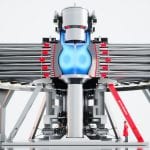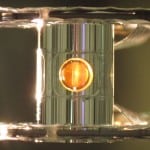The joke about fusion energy is that it’s 30 years away and always will be. But significant recent advances in fusion science and technology could potentially put the first fusion power on the grid as soon as the 2040s.
When British physicist Arthur Stanley Eddington first proposed in the 1920s that the sun and stars were powered by the fusion of hydrogen into helium, his idea sparked a rush of research and speculation into the possibility of bringing this energy source to earth. It was not long before journalists and pulp fiction authors were predicting a time, surely not far away, when the world would be powered by simple fusion reactors requiring nothing more than abundant hydrogen from water.
Obviously, these early predictions were more than a little off-base. Vastly more is understood about the physics of fusion energy than in Eddington’s day, yet commercial electricity generation from fusion still remains a goal rather than a reality. Decades of overly enthusiastic predictions have led to a long-running joke that fusion is the energy source of the future—and always will be.
 |
|
1. The ITER project, shown during construction in February 2020, will be the first experiment to create a “burning,” or self-sustaining, fusion plasma. This photo shows the partly completed building that will house the fusion tokamak and its support systems. Courtesy: ITER |
Practical, economic generation from fusion is not yet here, and it’s a solid bet that it will not arrive on the grid before the 2030s. Yet that reality is considerably closer than many people realize. As the result of decades of scientific advancement by the U.S. and other nations, most of the key physics questions behind fusion have been answered. Meanwhile, the first reactor that should achieve “burn”—that is, self-sustaining fusion—is currently under construction in France, with operations set to begin within the next few years (Figure 1).
Though it may be premature for utility resource planners to begin preparing for electricity from fusion, the time is growing closer when it becomes an option alongside other large generation projects. Accordingly, power generation professionals can benefit from a clear understanding of the current fusion landscape and where things are likely to go over the next decade.
The Basics of Fusion
Fusion is a nuclear reaction in which two or more atomic nuclei combine to form one or more different atomic nuclei and often subatomic particles as well. The fusion of light elements releases energy due to the interplay of two opposing forces: the “strong” nuclear force, which holds protons and neutrons together in the nucleus, and the Coulomb force, which causes positively charged protons to repel each other.
At the very short distance scales of an atomic nucleus, the strong force overcomes Coulomb repulsion to bind the protons and neutrons together. When small nuclei are fused together, this increases the strong force nuclear binding, releasing energy in the form of radiation and/or emission of subatomic particles. (Larger nuclei—those above iron—do not release energy when they fuse, as the higher number of protons increases Coulomb repulsion.)
These nuclear binding forces are far stronger than the forces that hold electrons in orbit around a nucleus and influence the energy of chemical processes. This is why fusion fuels offer vastly higher energy density than chemical methods—about a million times denser than fossil fuels.
A variety of fusion reactions are possible. Proton-proton fusion is the process that powers stars like our sun. This gravity-powered reaction requires enormous densities and takes about a billion years to complete. Thus, it’s not something that would be practical for energy production on earth. Instead, terrestrial magnetic fusion experiments employ lower densities but far higher temperatures, around 100 million degrees Celsius. When confined at these temperatures, the nuclei can collide with sufficient speed to overcome Coulomb repulsion and fuse together.
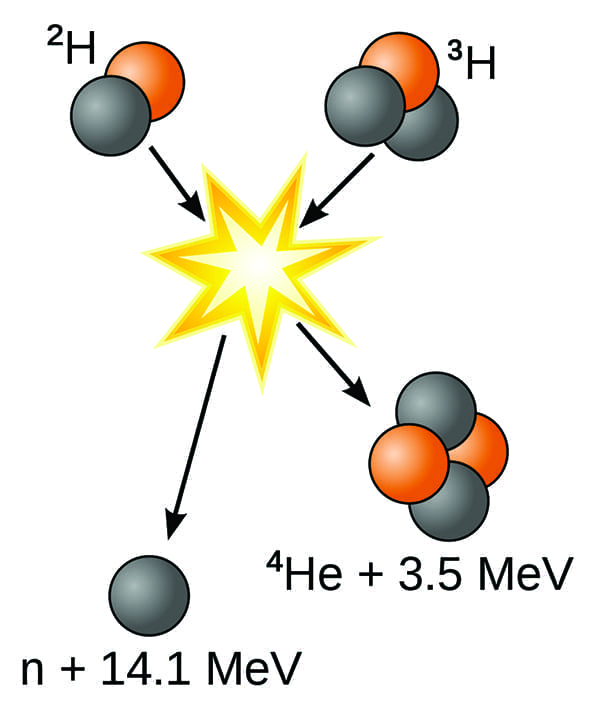 |
|
2. The deuterium-tritium reaction is considered by most scientists to be the most promising for fusion energy. When a deuterium nucleus (2H) and a tritium nucleus (3H) combine, the result is a helium nucleus and a very energetic neutron. Under the right circumstances, the energy released is sufficient to induce further fusion reactions. Source: Creative Commons/Wykis |
The deuterium-tritium (DT, Figure 2) reaction is the most useful for fusion energy because it most easily overcomes the Coulomb repulsion, and it has the highest energy release among laboratory-feasible reactions. However, the challenges involved in handling radioactive tritium and dealing with the copious amounts of energy and fusion products produced, means most present fusion experiments study the fusion of deuterium to deuterium (which has a lower fusion reaction rate) and then extrapolate the results to DT.
DT fusion produces an extremely energetic (14.1-MeV) neutron, which is potentially useful for breeding more tritium but also creates challenges for the surrounding materials in the tokamak (more on both of these below). The reaction also generates a helium nucleus that carries away about one-fifth of the reaction energy (3.5 MeV). In a fusion reactor, this nucleus shares its energy with the surrounding ions, keeping them hot and sustaining the fusion process.
The first DT reaction was achieved in 1932 at Cambridge University by Australian physicist Mark Oliphant. Though there are a number of methods by which fusion can be induced, consensus research into practical fusion energy has settled on magnetic confinement as the most promising for electricity generation. In this method, magnetic fields are used to confine hydrogen gas, which is heated until electrons separate from their nuclei, forming a plasma—an ionized “soup” of charged particles.
Most fusion research employs a magnetic confinement device known as a tokamak. First developed by Russian physicists Andrei Sakharov and Igor Tamm during the 1950s, a tokamak is a toroidal (that is, torus- or donut-shaped) vacuum vessel that uses powerful electromagnets to confine and shape the plasma. (The word tokamak is a Russian acronym for “toroidal confinement machine.”)
 |
|
3. A tokamak consists of a vacuum chamber surrounded by an array of electromagnetic coils that work together to confine the plasma inside strong magnetic fields (left). The DIII-D National Fusion Facility (interior shown at right) in San Diego is the largest operating tokamak in the U.S. Courtesy: General Atomics |
Creating and maintaining the confining magnetic fields in a tokamak requires three arrays of magnets (Figure 3). External coils around the ring of the tokamak produce the toroidal magnetic field, parallel to the circumference of the torus. The central solenoid uses a powerful pulse of energy that generates a toroidal current within the plasma. The movement of ions with this current in turn creates a second poloidal (parallel to the poles) magnetic field. Finally, poloidal coils around the circumference of the torus are used to control the position and shape of the plasma.
Rather than a single magnetic field, the arrangement results in an array of nested flux surfaces that confine the ionized particles in a variety of orbits in and around the tokamak. Because the particles in the plasma are tied to the magnetic fields, this field structure keeps the hottest parts of the plasma away from the walls, creating an insulating effect that allows very high temperatures to be achieved.
The induced plasma current provides a critical element of the magnetic confinement as well as a certain amount of heating, but this alone is not enough to induce fusion. Additional heating is typically provided by microwaves and particle beams.
Several dozen tokamaks are now in operation around the world. The first to demonstrate fusion at significant scale (10 MW) was the Tokamak Fusion Test Reactor (TFTR) device at the Princeton Plasma Physics Laboratory, though it has since shut down. The largest current device is the Joint European Torus (JET) in the UK, which has a radius of about 3 meters (m) and has made 16 MW of fusion power. A similar device in Japan is being upgraded to study techniques for future facilities and plasma sustainment. Smaller devices, like the DIII-D National Fusion Facility, which is operated for the Department of Energy by General Atomics in San Diego, are used to explore the physics for future facilities and develop techniques to raise fusion performance.
Some fusion research employs a device similar to a tokamak known as a stellarator. Rather than having a large plasma current, a stellarator uses a twisted array of helical windings around the torus to create the poloidal field externally. As a result, it does not need to generate a plasma current, which means it is capable of steady-state operation rather than needing a pulse of energy from the central solenoid. However, stellarators have more complicated geometry and are more difficult to build because of these additional windings. The approach is thought to offer considerable promise, and though past stellarators have encountered more problems with plasma confinement than tokamaks, the technology continues to draw research attention. The Wendelstein 7-X, an advanced stellarator that went online in Germany in 2015 (also the largest so far) is studying how well stellarators can contain energy and reach fusion conditions.
No current device has been able to generate more fusion power than the heating energy required to start the reaction. Scientists measure this assessment with a value known as fusion gain (expressed as the symbol Q), which is the ratio of fusion power to the input power required to maintain the reaction. Q = 1 represents the breakeven point, but because of heat losses, burning plasmas are not reached until about Q = 5. Current tokamaks have achieved around Q = 0.6 with DT reactions. Fusion power plants will need to achieve Q values well above 10 to be economic.
Current Activities and Challenges
The many potential benefits of fusion as an energy source are the reason it has long been viewed as an ideal method of generation. The fuel—isotopes of hydrogen—is readily available, and the only by-product is helium. Like a gas, coal, or fission plant, a fusion plant could operate around the clock, yet without producing any harmful emissions or long-lived radioisotopes. The risk of accidents with a fusion plant is very limited—if containment is lost, the fusion reaction simply stops. Though fusion is not risk-free, no explosions or wide-scale releases of energy are possible.
Getting to practical generation has been the key challenge. After more than 60 years of research in magnetic confinement fusion, most of the remaining impediments to fusion energy are those of engineering rather than science, though there are still important physics questions being investigated.
Plasma Confinement. Confining a fusion plasma inside a magnetic field is a bit like squeezing water inside a balloon. Differences in pressure, temperature, and density can cause the fields to balloon outward or spring a leak.
Researchers have been able to confine fusion plasmas long enough to generate fusion reactions for many years. However, the quality of plasma confinement—defined as the time required to lose energy to the vessel walls—is a key element in the cost-effectiveness of a hypothetical fusion power plant. This confinement time needs to be long enough to allow sufficient plasma energy to circulate in the confined region so that confined ions are kept hot enough to maintain an appropriate level of fusion. Current devices have managed confinement times of about 0.3 seconds; fusion power plants will likely need times of a few seconds, levels they theoretically should achieve with their larger size and stronger magnetic fields.
Recent studies have identified confinement quality as the most important factor for reducing capital costs, because it has a direct impact on the necessary size of the tokamak as well as other critical elements of the plant, such as the handling of heat and particle loads. Further research is necessary to develop higher-quality confinement solutions that would reduce these costs.
Though high-temperature superconducting materials, which can generate much stronger magnetic fields, have created some excitement in the fusion community, it is not yet known how well these will perform in operation, and studies have suggested that the choice of magnet technology may have relatively little impact on cost-effectiveness.
Tokamak Materials. The neutron radiation produced by DT fusion is an order of magnitude more energetic than that produced by nuclear fission. In addition, the helium generated by the reaction, as well as excess heat and other impurities in the plasma, must be removed on an ongoing basis during operation. This exhaust path will be subject to extremely high temperatures and particle bombardment. No materials currently exist that can be confidently relied upon to survive these conditions over the life of a commercial power plant. Developing them is an active area of research, with work exploring new alloys, better materials, and even liquid surfaces and candidate solutions. Better understanding of how these materials behave in the reactor environment and their interaction with fusion performance is necessary.
Breeding Tritium. Deuterium is relatively abundant in nature, and sufficient supplies can be extracted from seawater. Tritium, however, is a radioactive isotope with a half-life of only 12.3 years. Though it exists naturally, it is far too rare to recover usefully from natural sources, and useable amounts must be manufactured. Current methods rely on extraction from the coolant in heavy-water reactors or bombardment of lithium targets in light-water reactors.
A single 500-MW fusion power plant is expected to require about 50 kilograms (kg) of tritium fuel per year. This amount is not only far in excess of current global production capacity (which is roughly 2–3 kg/year from aging facilities at CANDU reactors in Canada and South Korea), it also represents a cost factor that would reach into billions of dollars. Thus, fusion power plants will need a method to breed tritium in situ. Fortunately, the fusion reaction itself offers a potential means to do so.
Placing a lithium blanket around the tokamak would generate tritium (and further heat) as the fusion neutrons are captured by the lithium nuclei and spontaneously transition to tritium. Technology solutions to capture this tritium during operation are in development.
Power Generation. To be useful as a power plant, a fusion reactor obviously must generate electricity. Fusion researchers generally envision that heat from the tokamak will be used to drive turbine generators, but exactly how the heat off-take will function is still a matter requiring considerable engineering. While in a sense this is the most conventional part of the power plant design, the technological challenges remain significant, as for high efficiency, the device must operate at high temperatures. Most current designs envision a helium loop that would extract heat from the lithium blanket, and either drive a turbine directly or generate steam in a secondary loop.
ITER
Fusion scientists realized some time ago that existing tokamaks are simply not large or powerful enough to reach burning plasma conditions. In order to resolve the design of a power plant, research at power-plant scale is necessary. Thus, a long-term goal has been building a facility that would have the necessary capabilities.
The ITER project was born in November 1985, when Soviet General Secretary Mikhail Gorbachev proposed an international collaboration on fusion energy to President Ronald Reagan. The name was originally an acronym for International Thermonuclear Energy Reactor, though that has since been dropped in favor of another representation, that is, that iter is Latin for “the way,” namely, the way to fusion energy.
The ITER agreement was signed in 1987 by the U.S., the European Union (EU), Japan, and the Soviet Union (Russia has assumed the USSR’s membership role). Under the agreement, all members have equal access to the technology developed, though each member funds only a portion of the cost. The U.S. is responsible for about 9% of ITER funding, in a mix of cash and in-kind contributions.
Although initial work began in 1988, it took until 2001 before an engineering design was agreed upon. The U.S. withdrew from ITER in the late 1990s, though it would rejoin in 2003. China and the Republic of Korea also joined ITER in 2003, followed by India in 2005. This brought the coalition to seven groups comprising 35 nations, making ITER the largest multinational science project in history.
The current ITER agreement was signed in 2007, and a location near Aix-en-Provence in southern France was selected as the site of the facility. However, there were considerable challenges in getting such a large project with so many members off the ground. Construction proceeded somewhat fitfully for several years and fell badly behind schedule. The delays and budget overruns drew concern from several quarters, particularly the appropriations committees in Congress.
 |
|
4. This February 2020 fish-eye view above the ITER tokamak chamber under construction gives an idea of the impressive scale of the device. When complete, the tokamak will be nearly 13 meters across. Courtesy: ITER |
In 2015, Bernard Bigot, the former director of the French Atomic Energy Commission, was brought in to assume oversight of the project. Bigot was successful in establishing a professional project culture, and construction is now two-thirds complete. Initial ITER operations are scheduled for 2025, with DT operation set for 2035 (Figure 4).
ITER will have many capabilities that go well beyond current tokamaks. It will be the first device that can generate a burning plasma and explore the fundamentals of how a tokamak contains the fusion reaction and the process of self-heating. Using DT fusion, ITER will produce 500 MW of fusion power at a Q value of 10—smashing the current world record of 16 MW at a Q value of 0.67, which was achieved on JET in 1997.
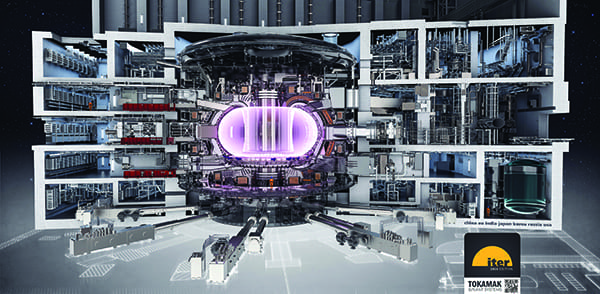 |
|
5. This cutaway schematic of the ITER facility shows the tokamak in the center with a simulation of the fusion plasma inside the tokamak. The entire device is about five stories tall. Courtesy: ITER |
ITER will be by far the largest and highest magnetic field tokamak in the world, and it will be powered by a central solenoid that will be the most powerful pulsed superconducting magnet ever constructed (Figure 5). Fabricated from 36 km of superconducting cable, this 1,000-ton magnet will drive 15 million amperes of current through the plasma, far more than anything that has been possible before. The U.S. is supplying the ITER central solenoid, which is currently being manufactured by General Atomics. The first of six modules that will comprise the central solenoid has finished testing and is being shipped to France this summer.
In addition, ITER will serve as a test bed for a number of critical fusion technologies, including tritium breeding, plasma control, advanced diagnostics, and disruption mitigation. Though it will not operate as a power plant, ITER will test safety features that future fusion power plants will require.
As a first-of-a-kind research and demonstration project, ITER is naturally quite expensive. Because most of the contributions are in-kind components produced in the member nations under different public financing approaches, an exact total of ITER’s costs is impossible to produce. However, a rough estimate generated by the ITER organization in 2016 was around $20 billion through start of DT operations in 2035. As large as that figure may seem, it is spread across a coalition of 35 nations, all of which will share in the technology ITER develops.
Private Fusion CompaniesSince all of these companies are privately held, full details are not available on their technologies and financing, but it is estimated that at least $1 billion in investment funding has flowed into private fusion. Short summaries of some of the efforts are given below.
TAE Technologies. TAE has been working for about 20 years on an approach known as field-reversed configuration (FRC). TAE’s technology, rather than relying on deuterium-tritium (DT) fusion, instead seeks to fuse hydrogen and boron. Though this is a more difficult reaction to achieve—requiring temperatures at least an order of magnitude higher—it has the advantage of not producing the highly energetic neutrons that complicate DT fusion. FRC is a magnetic confinement method forming a toroidal plasma, but without a toroidal magnetic field (Figure 6). TAE is based in Irvine, California. Its publicly announced funding totals $700 million, and known investors include Google. Commonwealth Fusion Systems (CFS). A spin-off from the Massachusetts Institute of Technology’s (MIT’s) Plasma Science and Fusion Center, CFS is pursuing a fairly conventional tokamak approach, but leveraging high-technology advances that came too recently to be incorporated into ITER. Foremost among these is the use of rare earth barium copper oxide (REBCO) superconductor (ITER employs niobium-tin). It is hoped this will allow for smaller, more efficient, and less expensive magnets. CFS is continuing a collaboration with MIT to develop a design for a compact high-field tokamak, called SPARC, that would produce 50 MW to 100 MW of fusion power at a Q value of 3. Construction of SPARC is slated to begin soon. MIT is one of the investors in CFS; others include several venture capital funds. General Fusion. This Vancouver, British Columbia–based company is pursuing one of the more revolutionary approaches, which it calls magnetized target fusion (MTS). The MTS concept uses a sphere filled with molten lead-lithium, which is then pumped to form a vortex. A pulse of magnetically confined plasma fuel is injected into the vortex, and an array of pistons creates a shock wave in the liquid metal to compress the plasma to fusion conditions. Heat from the liquid metal will then be captured and used to generate electricity. The company is supported by Amazon CEO Jeff Bezos, Microsoft, and venture capital. Tokamak Energy. A UK company, Tokamak Energy is working on magnetic confinement fusion, but employing a tokamak with a more spherical shape, based on a concept developed in the U.S. and the UK. This device, called ST40, has been commissioned and research on it is currently ongoing. Tokamak Energy claims to have achieved plasma temperatures of up to 15 million degrees Celsius. It most recently raised about $86 million in a January 2020 funding round. |
ITER is not the only undertaking generating excitement in the fusion community. At least a dozen private start-up companies have begun investigating alternative approaches to fusion energy over the past decade (see sidebar). Some of them are working on slightly different magnetic confinement methods, others are pursuing truly innovative—if high-risk—methods that could produce dramatic breakthroughs. All of them are looking for paths to fusion that are simpler and less expensive than ITER.
Fusion Development After ITER
What will come after ITER? The details are still to be determined, but a number of targets are in sight. If all goes well, the technology from ITER should enable electricity generation from fusion, and member nations are not waiting until the late 2030s to begin planning. Several follow-on devices that will be even higher performance than ITER are in development.
The ITER coalition has referred to this next step as the DEMO phase, and several conceptual designs for DEMO devices are in development in the EU, U.S., Korea, and China. DEMO-stage devices are expected to be simpler and less expensive than ITER, because they will be designed for power generation rather than research, as well as being “always on” devices that operate in steady state rather than exploring different fusion regimes. Of these, China’s may be the closest to operation.
 |
|
7. The China Fusion Engineering Test Reactor, shown in this artist’s impression, could begin operations in the late 2030s. Courtesy: China Institute of Plasma Physics |
Known as the China Fusion Engineering Test Reactor (CFETR, Figure 7), this device is in the design and technology prototyping phase. CFETR will be slightly larger than ITER, with a radius of about 7 m. Its initial phase will demonstrate fusion operation at about 200 MW fusion power, but it will eventually be upgraded to at least 2 GW fusion power and 700 MW net generation. Formal construction of the device is slated to begin in the 2020s, but construction of supporting facilities and key prototype components has already begun at a location in Hefei.
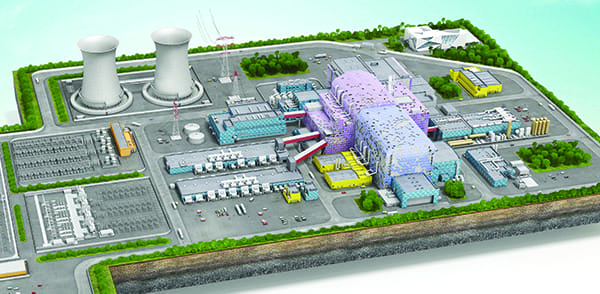 |
|
8. This artist’s impression shows a possible layout for the European DEMO fusion power plant that could be built after ITER. Courtesy: EUROfusion |
The European DEMO device is also intended as a demonstration power plant, with net generation of 300 MW to 500 MW (Figure 8). The pathway to DEMO has been laid out in a roadmap produced by EUROfusion, the EU’s fusion organization, but the location, construction start, and other details remain to be determined.
In the U.S., various proposals have been made for more compact and lower-capital-cost fusion reactors, with concepts such as MIT’s SPARC, Princeton Plasma Physics Laboratory’s Spherical Tokamak Power Plant, and General Atomics’ Compact Advanced Tokamak building in elements of higher magnetic field technology, increased plasma shaping, and higher plasma pressure operation to reach a more efficient configuration at compact scale.
Until recently, progress toward fusion energy in the U.S. has been principally focused on pure fusion science. Funding toward engineering challenges has been periodically complicated by political issues, over both the cost of ITER and the direction of the country’s energy policies. Still, Congress has increased appropriations for the Department of Energy’s (DOE’s) Office of Fusion Energy Science (FES) 44% since 2015, to $671 million in fiscal year 2020. Funding for the U.S. commitment to ITER has likewise been increased.
A report from the National Academies of Science in 2019 strongly recommended that the U.S. remain a member of ITER but also pursue the goal of a compact pilot fusion plant that would have higher power density and lower capital cost than larger DEMO designs. This plant would likely have net generation of about 200 MW to 300 MW. The preference for a smaller design reflects the economic realities of electricity generation in the U.S. and the practical need to advance the technologies first at the least cost.
The DOE’s Fusion Energy Sciences Advisory Committee (FESAC) is currently working on a report that would consider the feasibility of such a pilot plant. The study is expected to be completed later this year.
Fusion on the Grid
When will we see fusion as a meaningful element of the power mix? In this, it is worth remembering that practical fission generation was first demonstrated in the 1940s, yet it was not until the mid-1960s that commercial nuclear plant construction began on a large scale. Several of the earliest fission plants were public-private partnerships between utilities and the Atomic Energy Commission. The first U.S. fusion plants could follow a similar model, assuming Congressional appropriators agree to fund them. This does suggest, however, that large-scale commercial fusion energy should not be expected before the 2050s, roughly 20 years after ITER begins DT operations.
It is not yet clear how the Nuclear Regulatory Commission (NRC) will approach fusion generation. Much of how a fusion plant would be built and operated does not fit within existing NRC regulations, a fact the NRC itself has recognized. The fusion industry has begun engaging with the NRC on what such a regulatory approach would look like, but no official rulemaking has begun, nor is it likely to until the technology of fusion power plants is considerably clearer. Both federal and state regulatory environments will need to be adapted for fusion, a process that is likely to be drawn out and subject to extensive litigation.
Though this article has focused on scientific and engineering factors, the ultimate deciding factors will be social and economic. Fusion power plants will be built when investors and public utility commissions begin viewing them as worthwhile investments. Exactly when that point will be reached is difficult to say.
It is likely that electricity from the first fusion plants will be expensive compared to other options, though the same was once true about large-scale renewable generation. Fusion generation is certainly amenable to economies of scale, but the U.S. market has been trending away from very large (GW-scale) generation projects. The proposed approach of developing a compact fusion pilot plant thus represents a strategic way to develop the technology before scaling up once the investment community has gained confidence in the economics of larger plants.
Another important factor is public acceptance and the degree to which fusion will need to contend with perceptions and misconceptions about fission plants. The general public’s understanding of fusion energy is quite low, and confusion between fission and fusion is common. Both the fusion community and prospective plant owners will need to be proactive in providing effective communication about the technology long before any actual construction begins.
It is worth noting that the likely time frame roughly coincides with the period when many U.S. fission plants will be reaching the end of their license periods, as well as with the 2050 target date for net-zero carbon emissions that is the subject of significant attention worldwide. In such an environment, the advantages of fusion power could well be economically and socially compelling. ■
—Thomas W. Overton, JD is science editor with General Atomics in San Diego, California.










